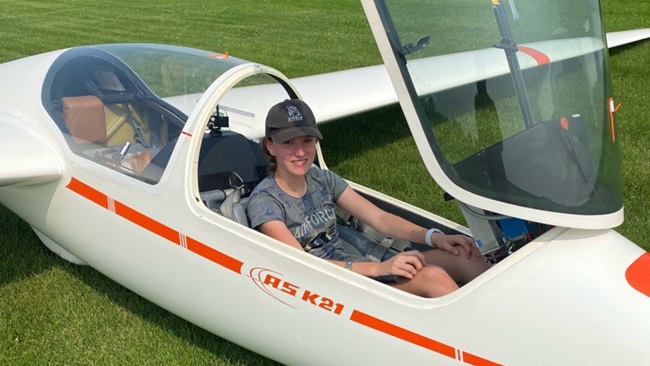Split personality
The Stemme S12 is two aircraft in one

The Stemme S12 is an evolution of the S10 motorglider designed 41 years ago by company founder and avid glider pilot Reiner Stemme, who holds a doctorate in physics. The S12 features a retractable carbon fiber propeller connected by a carbon fiber shaft to a piston engine mounted in the middle of a composite fuselage. After all these years, this remains a unique formula for a powered aircraft that is also capable of long-distance soaring flights.


Bustling factory
Stemme (pronounced shtem-muh) moved production from its Strausberg, Germany, headquarters to Pasewalk in 2023 after it acquired composite aircraft manufacturer Remos. Although Stemme ceased production of Remos aircraft, the company kept Remos’ highly skilled employees who excel at building the sophisticated composite S12 motorglider.
Pierre van Wetter, Stemme vice president of sales, and Koenraad Geurts, Stemme co-chief executive officer, show me the bustling factory as 1980s American pop music plays distantly over the facility’s loudspeakers. Every part of the airframe is made here—cockpit, inner wings, outer wings, winglets, tail boom, rudders, propellers, and canopies.
Carbon fiber shells for each component are created in specially designed molds, to which employees add layers of preimpregnated carbon fiber and fiberglass along with carefully placed brackets and fittings. Geurts jokes Stemme is the highest consumer of ice cream cups in the region—the cups are used to mix resin. Each component is baked in a room-sized oven at 104 degrees Fahrenheit for 24 hours, then moved into a 122-degree Fahrenheit oven for another 24 hours to fully cure.
The secret to the S12’s strength is a machine that winds 24 individual strands of carbon fiber into ropes called rovings. The rovings are bonded into the fuselage and wings, adding significant strength by reenforcing the engine mounting points in the fuselage, and adding tension to the incredibly long wing spars. It’s the rovings that enable the wings to bend without breaking.
The S12’s modular fuselage has a steel frame center section that carries the engine, wing, and retractable gear. Stemme uses more than 160 custom parts to modify each Rotax 914 F2 engine so that it will fit and operate reliably within the slim fuselage behind the cockpit. Modifications include relocating the turbo and ignition unit, adding extra cooling, and shielding the exhaust system.
After nine months of production time, a new S12 and any options a customer has ordered come together in final assembly. Considering its compact size, the S12 offers an impressive array of options. A buyer’s two main choices include instrumentation and wing length. The S12 comes standard with traditional analog gauges while the S12-G features dual Garmin G3X 7-inch touchscreen integrated flight displays with air data and attitude heading reference system (ADHRS), digital engine monitoring, moving map navigation, and autopilot control. Either model can be ordered with long or short wing tips (82 and 71.2 feet wing span, respectively). The standard LX9000 soaring computer can optionally include Wi-Fi to upload flight plans from your mobile device, a flap sensor, and a remote control mounted on one or both control sticks. Additional options include extra oxygen bottle mounts, a spare pitot tube, and an electrical wing bug wiper to reduce drag. “Some of our customers are pure gliding pilots and they want to have the best performance,” said van Wetter.



Motorgliding
Stemme’s headquarters and maintenance facilities are located at Berlin Strausberg Airfield (EDAY). Here I meet Martin Just, Stemme head of service and after sales, and a flight instructor—the perfect person to show me the finer points of motorglider flight while being intimately familiar with the mechanical workings of the aircraft. We’re flying a 2025 Stemme S12-G with 71-foot wings, soon destined for its new owner in the United States.
Preflight begins by unfolding the outer wings and sliding them into the inner wings. Both wing sections cleverly remain connected throughout the operation by a sliding pivot point. Sliding pins lock the wings in place. The winglets are slid into the outer wings and similarly locked tight. Once the dance is learned, it can be accomplished by one person in less than 5 minutes.
The S12 is typically stored with the propeller in the stowed position behind the nose cone. During preflight, the nose cone is moved to the open position using a lever in the cockpit causing the propeller blades to partially unfold (they will fully extend during engine startup).
Next, the carbon fiber pitot tube is installed. The pitot tube extends almost two feet from the nose cone, and Stemme said people occasionally walk into the pitot tube, cracking it. Any damage to the pitot tube is a no-go for flight, which is why most owners buy a spare pitot tube and keep it in a special holder behind the seatbacks.
We check the S12’s tail ballast tank that holds up to 15 liters of water to precisely adjust the aircraft’s center of gravity. It’s simple and effective.
Although the luggage compartment in the tail boom holds 44 pounds, Stemme also found space behind the seatbacks for additional storage and carved out a small document compartment between the seats. No mean feat given the snug confines.
The seats are not adjustable fore and aft, but the rudder pedals are. Seat back rake can be adjusted, but only before you get into the aircraft. Once inside, especially with a parachute on your back and your five-point harness in place, there is no way to further adjust the seat. Parachutes are not required unless you’re performing aerobatics (the S12 is rated plus-5.3 G and minus-2.6 G), but if anything goes wrong, the canopy can be jettisoned to aid egress.
Engine startup is normal, but the immediate challenge is taxiing with 71-foot-long wings. It’s imperative to ensure our taxi route will enable us to clear taxi signs and lights, and avoid acute angle turns. Although the S12 has a steerable tailwheel, it has a wide turn radius and Just said a tight turn could require shutting down the engine and moving the motorglider by hand. The sight picture while taxiing is typical for a tailwheel aircraft, with no view over the nose but a good view 15 degrees left and right. Shallow S-turns are required to see what’s straight ahead.
Final pre-takeoff checks include setting the two-speed propeller for climb (the other setting is for cruise) and ensuring the fuel selector is set on both 16-gallon main fuel tanks.
The wind is nearing the S12’s maximum demonstrated crosswind component of 9 knots on EDAY’s hard-surface Runway 23. This will require using some aileron to counter the crosswind, but not too much lest a wingtip drag the ground. It’s a delicate balance that takes practice, so I happily let Just perform the takeoff.
The takeoff roll takes a bit longer than I expect from a glider, but at 47 knots, Just rotates smartly, sets climb speed at 62 knots (VY), and retracts the electromechanically operated landing gear. With its huge wing area, the airplane levitates off the ground. The sight picture appears more nose down than I anticipated despite our better than 650 fpm rate of climb on this cool spring day. The view is outstanding in all directions except for directly behind the cockpit.
Just hands the controls to me, and upon reaching 2,000 feet I set the propeller to economy-cruise pitch and see 120 knots indicated. I perform some maneuvers to get familiar with the controls and love the very direct aileron and elevator feel, courtesy of pushrod linkages. The aileron flap (flaperon) mix is highly differentiated, so turns at cruise speed require only gentle rudder inputs to remain coordinated. The rudder and tailwheel are operated by cables.
We fly over downtown Berlin and I eagerly take photos of notable landmarks including the Berlin TV Tower at Alexanderplatz, Brandenburg Gate and, of course, Berlin Tempelhof Airport (EDBB).
Clearly the S12 is a capable powered cruiser, but at its core this aircraft is a glider—the engine merely a means to find lift. Unfortunately, the atmosphere on this day is calm and mostly cloudless. Instead of stowing the propeller and turning the engine off just yet, Just instructs me to bring power to idle and leverage our 1-to-53 glide ratio while we seek lift using the digital variometer. No beeps or slow low-tone beeps from the variometer indicate areas of little lift. Increasingly quick and higher pitch beeps indicate areas of higher lift—often associated with vertically developing clouds. The variometer remains stubbornly silent, so we head back to the airport for an engine off landing.
A few miles from the airport, Just coaches me through the propeller stowage sequence. I set the propeller to takeoff pitch, slow to 54 knots, wait until the oil temperature cools below 212 degrees Fahrenheit, and turn the engine off. I stop the windmilling propeller by pulling the propeller brake handle. Next, I pull the propeller positioning handle to fold and position the propeller for stowage and finally I pull the nose cone handle to fully enclose the folded propeller.
My aerial experience is transformed. Engine noise is replaced by a light rushing of wind. We take our headsets off and use normal voices to talk to each other and a goose neck microphone and speakers to communicate with the tower.


Just guides me on my first glider landing. As with any airplane, a stabilized approach is rewarded with a good landing and managing airspeed and altitude is key.
Entering downwind, I focus on maintaining my target airspeed of 59 knots and keeping the ball centered to remain coordinated in turns. In a glider, speed is managed with pitch—slipping or skidding will cause the aircraft to sink faster—and power is not an option to regain lost altitude.
As I make my base turn at 59 knots, the S12’s long wings induce noticeable adverse yaw and, despite the S12’s technically advanced nature, it’s intuitive and comforting to use the simple yaw string affixed to the canopy to remain coordinated. Aiding this phase of flight, the wings have air disrupters to make the controls more efficient at low speed.
As I turn final, Just uses the wing air brakes to fine tune our altitude and admonishes me instantly if the ball is not centered. The final approach and flare will feel completely normal to any tailwheel pilot, especially if you routinely make power-off approaches. The robust landing gear cushions the weight of the aircraft nicely during the wheel landing and the tail settles to the ground at around 25 knots. Propeller unfolding and engine startup takes about 15 seconds, and we’re taxiing back to the hangar.
Since I only have a single-engine land rating, I can’t log the flight time because the S12 is EASA certified as a powered sailplane, not an airplane. In the United States, the S12 is certified as a glider and pilots must have a glider certificate with a motorglider endorsement to act as pilot in command, unless they are a student pilot.

Two aircraft in one
The versatility of the S12 is impressive. The motorglider provides the freedom to fly to a location of your choice—even one more than 900 miles away—turn off the engine and soar for hours (solar cells power the LX9000 soaring computer when the engine and Garmin avionics are turned off) then use the engine to return to the airport or landing zone of your choice.
The unique design has been refined and enhanced for more than 40 years thanks to passionate engineers and craftsman in northeastern Germany, and it remains one of a kind.



 stemmeusa.co
stemmeusa.co

